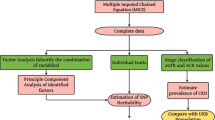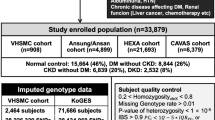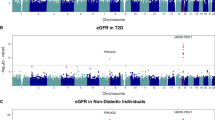Abstract
Aims/hypothesis
Diabetic nephropathy is a major diabetic complication, and diabetes is the leading cause of end-stage renal disease (ESRD). Family studies suggest a hereditary component for diabetic nephropathy. However, only a few genes have been associated with diabetic nephropathy or ESRD in diabetic patients. Our aim was to detect novel genetic variants associated with diabetic nephropathy and ESRD.
Methods
We exploited a novel algorithm, ‘Bag of Naive Bayes’, whose marker selection strategy is complementary to that of conventional genome-wide association models based on univariate association tests. The analysis was performed on a genome-wide association study of 3,464 patients with type 1 diabetes from the Finnish Diabetic Nephropathy (FinnDiane) Study and subsequently replicated with 4,263 type 1 diabetes patients from the Steno Diabetes Centre, the All Ireland-Warren 3-Genetics of Kidneys in Diabetes UK collection (UK–Republic of Ireland) and the Genetics of Kidneys in Diabetes US Study (GoKinD US).
Results
Five genetic loci (WNT4/ZBTB40-rs12137135, RGMA/MCTP2-rs17709344, MAPRE1P2-rs1670754, SEMA6D/SLC24A5-rs12917114 and SIK1-rs2838302) were associated with ESRD in the FinnDiane study. An association between ESRD and rs17709344, tagging the previously identified rs12437854 and located between the RGMA and MCTP2 genes, was replicated in independent case–control cohorts. rs12917114 near SEMA6D was associated with ESRD in the replication cohorts under the genotypic model (p < 0.05), and rs12137135 upstream of WNT4 was associated with ESRD in Steno.
Conclusions/interpretation
This study supports the previously identified findings on the RGMA/MCTP2 region and suggests novel susceptibility loci for ESRD. This highlights the importance of applying complementary statistical methods to detect novel genetic variants in diabetic nephropathy and, in general, in complex diseases.



Similar content being viewed by others
Abbreviations
- ACR:
-
Albumin/creatinine ratio
- BAI:
-
Body adiposity index
- BoNB:
-
Bag of Naive Bayes
- DBP:
-
Diastolic blood pressure
- eGFR:
-
Estimated GFR
- ESRD:
-
End-stage renal disease
- FDR:
-
False discovery rate
- FinnDiane:
-
Finnish Diabetic Nephropathy Study
- GENIE:
-
Genetics of Nephropathy–an International Effort
- GoKinD US:
-
Genetics of Kidneys in Diabetes US Study
- GWAS:
-
Genome-wide association study
- MCC:
-
Matthews correlation coefficient
- NBC:
-
Naive Bayes classifier
- SBP:
-
Systolic blood pressure
- SNP:
-
Single nucleotide polymorphism
- UK-ROI:
-
All Ireland-Warren 3-Genetics of Kidneys in Diabetes UK collection (UK and Republic of Ireland)
References
Andersen AR, Christiansen JS, Andersen JK, Kreiner S, Deckert T (1983) Diabetic nephropathy in type 1 (insulin-dependent) diabetes: an epidemiological study. Diabetologia 25:496–501
Groop PH, Thomas MC, Moran JL et al (2009) The presence and severity of chronic kidney disease predicts all-cause mortality in type 1 diabetes. Diabetes 58:1651
Parving HH (1996) Initiation and progression of diabetic nephropathy. N Engl J Med 335:1682–1683
Rossing P, Hougaard P, Parving HH (2002) Risk factors for development of incipient and overt diabetic nephropathy in type 1 diabetic patients: a 10-year prospective observational study. Diabetes Care 25:859–864
Forsblom C, Harjutsalo V, Thorn LM et al (2011) Competing-risk analysis of ESRD and death among patients with type 1 diabetes and macroalbuminuria. J Am Soc Nephrol 22:537–544
Seaquist ER, Goetz FC, Rich S, Barbosa J (1989) Familial clustering of diabetic kidney disease. N Engl J Med 320:1161–1165
Harjutsalo V, Katoh S, Sarti C, Tajima N, Tuomilehto J (2004) Population-based assessment of familial clustering of diabetic nephropathy in type 1 diabetes. Diabetes 53:2449–2454
Pezzolesi MG, Poznik GD, Mychaleckyj JC et al (2009) Genome-wide association scan for diabetic nephropathy susceptibility genes in type 1 diabetes. Diabetes 58:1403–1410
Craig DW, Millis MP, DiStefano JK (2009) Genome-wide SNP genotyping study using pooled DNA to identify candidate markers mediating susceptibility to end-stage renal disease attributed to Type 1 diabetes. Diabet Med 26:1090–1098
Sandholm N, Salem RM, McKnight AJ et al (2012) New susceptibility loci associated with kidney disease in type 1 diabetes. PLoS Genet 8:e1002921
Bansal V, Libiger O, Torkamani A, Schork NJ (2010) Statistical analysis strategies for association studies involving rare variants. Nat Rev Genet 11:773–785
Thorn LM, Forsblom C, Fagerudd J et al (2005) Metabolic syndrome in type 1 diabetes: association with diabetic nephropathy and glycemic control (the FinnDiane study). Diabetes Care 28:2019–2024
Sambo F, Trifoglio E, Di Camillo B, Toffolo GM, Cobelli C (2012) Bag of Naive Bayes: biomarker selection and classification from genome-wide SNP data. BMC Bioinforma 13(Suppl 14):S2
Tarnow L, Groop PH, Hadjadj S et al (2008) European rational approach for the genetics of diabetic complications—EURAGEDIC: patient populations and strategy. Nephrol Dial Transplant 23:161–168
Makinen VP, Forsblom C, Thorn LM et al (2008) Metabolic phenotypes, vascular complications, and premature deaths in a population of 4,197 patients with type 1 diabetes. Diabetes 57:2480–2487
Bergman RN, Stefanovski D, Buchanan TA et al (2011) A better index of body adiposity. Obesity (Silver Spring) 19:1083–1089
Niemi J, Makinen VP, Heikkonen J et al (2009) Estimation of VLDL, IDL, LDL, HDL2, apoA-I, and apoB from the Friedewald inputs—apoB and IDL, but not LDL, are associated with mortality in type 1 diabetes. Ann Med 41:451–461
Friedewald WT, Levy RI, Fredrickson DS (1972) Estimation of the concentration of low-density lipoprotein cholesterol in plasma, without use of the preparative ultracentrifuge. Clin Chem 18:499–502
Levey AS, Stevens LA (2010) Estimating GFR using the CKD Epidemiology Collaboration (CKD-EPI) creatinine equation: more accurate GFR estimates, lower CKD prevalence estimates, and better risk predictions. Am J Kidney Dis 55:622–627
Purcell S, Neale B, Todd-Brown K et al (2007) PLINK: a tool set for whole-genome association and population-based linkage analyses. Am J Hum Genet 81:559–575
Price AL, Patterson NJ, Plenge RM, Weinblatt ME, Shadick NA, Reich D (2006) Principal components analysis corrects for stratification in genome-wide association studies. Nat Genet 38:904–909
Howie BN, Donnelly P, Marchini J (2009) A flexible and accurate genotype imputation method for the next generation of genome-wide association studies. PLoS Genet 5:e1000529
1000 Genomes Project Consortium, Abecasis GR, Auton A et al (2012) An integrated map of genetic variation from 1,092 human genomes. Nature 491:56–65
Baldi P, Brunak S, Chauvin Y, Andersen CA, Nielsen H (2000) Assessing the accuracy of prediction algorithms for classification: an overview. Bioinformatics 16:412–424
Willer CJ, Li Y, Abecasis GR (2010) METAL: fast and efficient meta-analysis of genomewide association scans. Bioinformatics 26:2190–2191
Benjamini Y, Hochberg Y (1995) Controlling the false discovery rate: a practical and powerful approach to multiple testing. J R Stat Soc Ser B 57:289–300
O'Connor BP, Eun SY, Ye Z et al (2008) Semaphorin 6D regulates the late phase of CD4+ T cell primary immune responses. Proc Natl Acad Sci U S A 105:13015–13020
Zhou T, He X, Cheng R et al (2012) Implication of dysregulation of the canonical wingless-type MMTV integration site (WNT) pathway in diabetic nephropathy. Diabetologia 55:255–266
Stark K, Vainio S, Vassileva G, McMahon AP (1994) Epithelial transformation of metanephric mesenchyme in the developing kidney regulated by Wnt-4. Nature 372:679–683
Kispert A, Vainio S, McMahon AP (1998) Wnt-4 is a mesenchymal signal for epithelial transformation of metanephric mesenchyme in the developing kidney. Development 125:4225–4234
Surendran K, McCaul SP, Simon TC (2002) A role for Wnt-4 in renal fibrosis. Am J Physiol Renal Physiol 282:F431–F441
Terada Y, Tanaka H, Okado T et al (2003) Expression and function of the developmental gene Wnt-4 during experimental acute renal failure in rats. J Am Soc Nephrol 14:1223–1233
Lin CL, Wang JY, Huang YT, Kuo YH, Surendran K, Wang FS (2006) Wnt/beta-catenin signaling modulates survival of high glucose-stressed mesangial cells. J Am Soc Nephrol 17:2812–2820
Moore JH, Asselbergs FW, Williams SM (2010) Bioinformatics challenges for genome-wide association studies. Bioinformatics 26:445–455
Gibson G (2012) Rare and common variants: twenty arguments. Nat Rev Genet 13:135–145
Mukhopadhyay I, Feingold E, Weeks DE, Thalamuthu A (2010) Association tests using kernel-based measures of multi-locus genotype similarity between individuals. Genet Epidemiol 34:213–221
Lee S, Emond MJ, Bamshad MJ et al (2012) Optimal unified approach for rare-variant association testing with application to small-sample case-control whole-exome sequencing studies. Am J Hum Genet 91:224–237
Di Camillo B, Sambo F, Toffolo G, Cobelli C (2013) ABACUS: an entropy based cumulative bivariate statistic robust to rare variants and different direction of genotype effect. Bioinformatics 30:384–391
Di Camillo B, Sanavia T, Martini M et al (2012) Effect of size and heterogeneity of samples on biomarker discovery: synthetic and real data assessment. PLoS One 7:e32200
Sebastiani P, Ramoni MF, Nolan V, Baldwin CT, Steinberg MH (2005) Genetic dissection and prognostic modeling of overt stroke in sickle cell anemia. Nat Genet 37:435–440
Sebastiani P, Solovieff N, Dewan AT et al (2012) Genetic signatures of exceptional longevity in humans. PLoS One 7:e29848
Malovini A, Barbarini N, Bellazzi R, de Michelis F (2012) Hierarchical naive Bayes for genetic association studies. BMC Bioinforma 13(Suppl 14):S6
Acknowledgements
We thank M. Parkkonen, A. Sandelin, A.-Reetta Salonen, T. Soppela and J. Tuomikangas for skilful laboratory assistance. We also thank all the patients who participated in the study and gratefully acknowledge all the physicians and nurses at each centre involved in the recruitment of participants (ESM Table 5). The members of the GENIE Consortium are listed in ESM Table 6.
Funding
The FinnDiane Study was supported by grants from the Folkhälsan Research Foundation, the Wilhelm and Else Stockmann Foundation, the Liv och Hälsa Foundation, Helsinki University Central Hospital Research Funds (EVO), the Sigrid Juselius Foundation, the Signe and Arne Gyllenberg Foundation, Finska Läkaresällskapet, the Novo Nordisk Foundation, the Academy of Finland (134379) and Tekes. The research was supported by the European Union's Seventh Framework Program (FP7/2007-2013) for the Innovative Medicine Initiative under grant agreement IMI/115006 (the SUMMIT consortium). The GENIE consortium was funded by National Institutes of Health/National Institute of Diabetes and Digestive and Kidney Diseases (NIH NIDDK) R01DK081923 and the Northern Ireland Research and Development Office. M. Stavarachi was supported by the Sectoral Operational Programme Human Resources Development (SOP HRD), financed from the European Social Fund and by the Romanian Government under contract number POSDRU/89/1.5/S/64109. V.-P. Mäkinen was supported by American Heart Association (13POST17240095).
Duality of interest
P-HG has received lecture honoraria from Abbot, Boehringer Ingelheim, Cebix, Eli Lilly, Genzyme, Novartis, Novo Nordisk and MSD, and research grants from Eli Lilly, Roche. P-HG is also an advisory board member for Boehringer Ingelheim, Novartis and Medscape.
Contribution statement
FS, AM, NS and M. Stavarachi analysed data and wrote the manuscript. CF contributed to the conception and design and acquisition of data, and revised the manuscript critically. V-PM contributed to the conception and design and revised the manuscript critically. VH, RL, DG, MP, M. Saraheimo, LMT, NT, JW, BH, A-MÖ, JT, ML, AJM, LT, KT, NMP and P-HG contributed to the acquisition of the genotypic and/or phenotypic data and revised the manuscript critically. RMS and AJM analysed data and revised the manuscript. NB, BD and GMT contributed to the interpretation of the results, revised and edited the manuscript. RB, CC and P-HG designed and supervised the study and revised the manuscript. All the authors approved the final version of the manuscript. P-HG is the guarantor of this work.
Author information
Authors and Affiliations
Consortia
Corresponding author
Additional information
F. Sambo, A. Malovini, N. Sandholm and M. Stavarachi contributed equally to this work.
The list of GENIE members is provided in the electronic supplementary material.
Electronic supplementary material
Below is the link to the electronic supplementary material.
ESM Table 1
(PDF 102 kb)
ESM Table 2
(PDF 108 kb)
ESM Table 3
(PDF 104 kb)
ESM Table 4
(XLS 35 kb)
ESM Table 5
(PDF 87 kb)
ESM Table 6
(PDF 74 kb)
Rights and permissions
About this article
Cite this article
Sambo, F., Malovini, A., Sandholm, N. et al. Novel genetic susceptibility loci for diabetic end-stage renal disease identified through robust naive Bayes classification. Diabetologia 57, 1611–1622 (2014). https://doi.org/10.1007/s00125-014-3256-2
Received:
Accepted:
Published:
Issue Date:
DOI: https://doi.org/10.1007/s00125-014-3256-2




